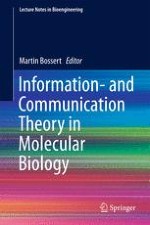2018 | OriginalPaper | Buchkapitel
13. Application of Methods from Information Theory in Protein-Interaction Analysis
verfasst von : Arno G. Stefani, Achim Sandmann, Andreas Burkovski, Johannes B. Huber, Heinrich Sticht, Christophe Jardin
Erschienen in: Information- and Communication Theory in Molecular Biology
Aktivieren Sie unsere intelligente Suche, um passende Fachinhalte oder Patente zu finden.
Wählen Sie Textabschnitte aus um mit Künstlicher Intelligenz passenden Patente zu finden. powered by
Markieren Sie Textabschnitte, um KI-gestützt weitere passende Inhalte zu finden. powered by
